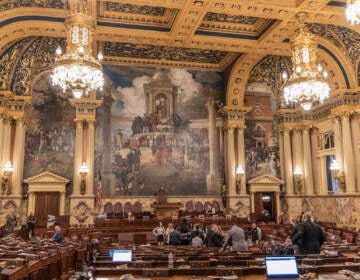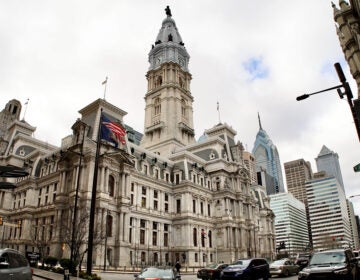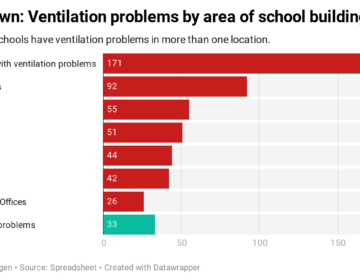Educators express doubts about Philadelphia’s school opening plan
More than 30 principals plan to speak at Thursday's board meeting.
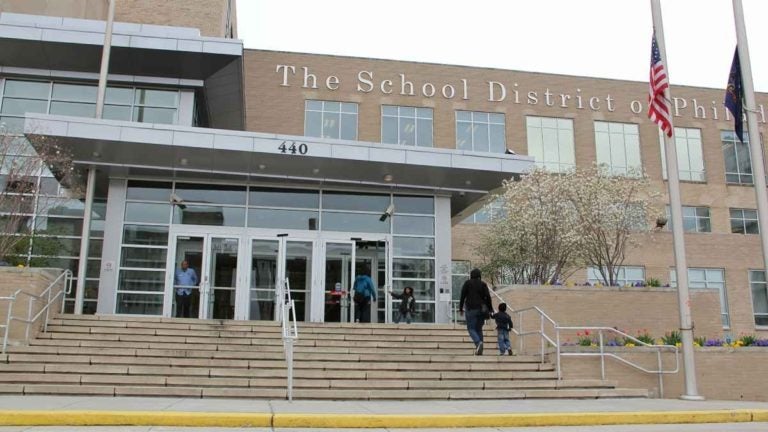
School District of Philadelphia. (Emma Lee/WHYY)
This article originally appeared on The Notebook.
___
Updated: 10 a.m.
As the Board of Education gets ready to hold a special meeting Thursday, the Philadelphia School District is facing a rising chorus of concern about Superintendent William Hite’s plan to reopen schools in September from the teachers and principals who will have to make it work.
On Tuesday, the unions for those two groups of school employees raised questions and doubts about the hybrid plan announced last week, in which most students will attend school two days a week and learn virtually the rest of the time.
The school board is scheduled to vote Thursday on a “health and safety plan” for school reopening as required by the Pennsylvania Department of Education. But it will not vote on the details of the District’s plan, which was assembled by Hite and his staff over the last several months largely out of the public eye, although it was informed by surveys of staff and families.
“We’ve received more than 3,500 submitted questions regarding the District’s plan. There is a tremendous amount of fear amongst my members,” said Jerry Jordan, president of the Philadelphia Federation of Teachers.
“There’s so many questions,” said Robin Cooper, head of the principals’ union, the Commonwealth Association of School Administrators (CASA).
And as their leaders share concerns, the rank and file appear outright unhappy or worse, with teachers and principals alike accusing District planners of overlooking the harsh material realities of Philadelphia schools and setting up overly rosy expectations. Social media has been alive with critiques, and no fewer than 32 Philadelphia principals plan to speak at the Board of Education meeting to air concerns.
“I’ve been a principal for 13 years, and I don’t know anybody who has the experience of planning for the first day of school from scratch,” said Jeannine Payne, principal of Richard Wright Elementary in North Philadelphia. “My colleagues and I have been working really hard to basically redesign schools, and it’s a lot.”
Principals say that they will drive home in their testimony to the board that COVID-19 is laying bare systemic inequities that have been too long ignored.
“In times of crisis, all the flaws [of the system] are brought out into the open. We can’t just gloss over things anymore,” said Ted Domers, principal of the Carver High School of Engineering & Science in North Philadelphia.
Just days ago, District officials unveiled their September plan, which calls for educators to work in school buildings four days a week to accommodate the two alternating groups of students. Some children – the youngest and those with complex needs – would attend school all four days.
Families are also given the option for students to opt out of their “home school” and enter a “digital academy,” about which little is known. More details are expected to be released Wednesday, and families will have until Aug. 4 to enroll.
Principals are expected to handle scheduling, oversight, and logistics for their buildings. Since its unveiling, the Hite administration’s plan, with a price tag of $60 million to $80 million, has been greeted with a smattering of support and a chorus of criticism.
Thursday will be the public’s first opportunity to react to the plan before the Board of Education, and the meeting will feature a long list of speakers, including the principals, who will be armed with an equally long list of questions.
Among the top concerns will be the challenge of upgrading ventilation in the District’s vast array of aging, often poorly maintained buildings – a critical “cleaning” issue that is in fact an infrastructure issue, and a costly and complex one.
“What we know from the data is that we have a $4.5 billion capital backlog going back 25 years. … A lot of that is ventilation and windows,” said Jerry Roseman, director of environmental science for the PFT’s Health and Welfare Fund. “It’s too big to fix in three months.”
Beyond that lie countless nuts-and-bolts building-level issues involving teachers and administrators: roster management, staff management, coordination of cleaning and inspections, maintenance of personal protective equipment, scheduling, and schoolwide adherence to protocols.
Principals are only just beginning to unpack what it means for them, Cooper said. Members talked over the plan for almost five hours on Friday, she said, and didn’t even come close to understanding how the “hybrid” reopening plan can work.
District officials are hosting a “town hall” for principals Wednesday, which may provide some additional clarity, but for now, school leaders feel that “everything is left on them with very little support on how to get it done,” Cooper said.
Unions complain: Engagement was cursory
Both unions also signaled dissatisfaction with the District’s planning process. District officials have long assured the public that the unions were a part of their discussions, but Cooper said that her members were not part of any “authentic” decision making.
“We were brought to the table in a superficial type of manner,” she said. “Union stakeholders have not been part of actual planning….District leaders meet among themselves, then invite folks after the decision making has occurred.”
PFT’s Roseman also said that District officials kept teachers – with whom they are negotiating a new contract – at too far a distance.
“My view is that what the District has done to date should be thought of as background research. It did not invite real stakeholders to the planning,” said Roseman, a consultant who works with the PFT and other unions on safety issues. Start now on a better plan and something could be ready for consideration by Thanksgiving, and implementation by January, he said.
For the current District plan, Roseman said the PFT was “consulted” but not closely engaged in the process. The result is a plan which he believes is impossible to implement by September.
“They don’t have the money, they don’t have the systems, and they don’t have the people. I think they’re kind of wasting time,” said Roseman.
Hite issued a statement Wednesday morning disputing to the unions’ contentions that they weren’t full partners:
Roseman’s leading concern with the plan is its lack of attention to ventilation – a make-or-break issue that defines what spaces can be safely used and what can’t, he said. Decisions about PPE and social distancing all come downstream from assessing air quality, he said; no amount of space between students protects them in an unventilated room.
And good air circulation is in short supply in District buildings, Roseman said. “On the ventilation end,” in the District as a whole, “there is a very small fraction of rooms that you can safely use.”
Upgrading such systems on a major scale across the District is not feasible, Roseman said. Likewise, asking principals to make “site specific mitigation” decisions is “an impossible task.”
To execute the District’s plan as written, he said, “would need an enormous amount of information and guidelines that don’t exist.” For instance, principals need to know “exactly” how to determine the number of students and staff that can be in a given space and under what conditions. With all the variation from building to building, very clear protocols are needed, he said – along with all the staff, materials, and resources needed to enforce them.
“I don’t think we’re on the path to an achievable plan,” said Roseman. By September, when schools are scheduled to open, he said: “I can’t see how schools can be safe.”
Principals are keenly aware of the challenges they now face. Each has a building with its own issues and idiosyncrasies, and few have the staff they truly need to stay clean. Toni Damon is principal of Dobbins CTE high school, an eight-story building in North Philadelphia with more than 900 students. Six of those floors are used regularly, she said, but her cleaning staff is just four or five people.
“They said the schools will be cleaned every four hours,” she said. “But how can you assure that when you don’t have the manpower?”
Even where systems are relatively new, she said, they can still fall short of COVID standards. Dobbins just underwent a $39 million renovation, she said, but some bathrooms still don’t have hot running water and “some issues with air conditioning and ventilation are still not resolved.”
For some principals, this is a symptom of a longstanding problem. A theme of the principals’ remarks on Thursday, Cooper and others said, will be how COVID-19 has exposed the systemic racism as a chronically underfunded urban district struggles to balance health and safety with the educational needs of a mostly Black and brown student population.
“There are no margins for us because of resources and the lack of funding,” said Domers, the Carver principal.
Whether any new funding is on the horizon is unknown, but signs aren’t encouraging at the moment. Hite and the Board of Education, along with the major teacher unions, are taking part in a national push to pass another federal stimulus bill featuring federal aid to schools – as are educators in the region’s better-off district. But the $3 billion HEROES act passed by the House remains stalled in the Senate.
Virtual academy raises real-world questions
Another major unknown is how many students will choose the so-called “digital academy” – an “all virtual” option the District is making available – and how that will affect rostering and staffing in their home schools.
“I think a lot of kids want to go virtual, but there’s so much unknown about what the virtual option is,” said Domers, who said he “can’t shake” the words of Dr. Thomas Farley, the city health commissioner, that it’s not “if, but when” someone will be infected in school.
The “digital academy” adds yet another variable to what is already a swirl of interlocking deadlines and decisions for students, parents and staff.
Principals are expected to submit their rosters by Friday. Using an algorithm, the central office will create the two groups of students, one that will attend Monday and Wednesday and the other Tuesday and Thursday. That algorithm will, as much as possible, assure that siblings attend on the same days.
But once those rosters are set, parents can still opt out, with the Aug. 4 deadline to enroll in the all-virtual option. How such enrollment drops will affect staffing levels in each building remains unknown.
“I haven’t even gotten there yet,” said the PFT’s Jordan recently.
Teachers face decisions, too. They can ask to teach virtually, citing health reasons relating to themselves or a member of their family. That means yet another variable for principals, who’ll have to wait to find out who’ll be available to teach whom.
“The first thing that came to mind for me is that I’m in a holding pattern. There’s so much more I need to know,” Domers said.
Another unknown that has caused social media chatter is a possible change in schedules, with staggered school start and end times to accommodate social distancing on busing and the need to avoid rush hour on public transportation for older students. Such a change has to be approved by the unions.
Damon, the Dobbins principal, said that beyond the practical problems, the “digital academy” raises questions about equity.
She thinks many of her families will choose the fully virtual option. But that doesn’t really work for her school because career and technical courses cannot be offered that way.
“My main thing is that the reopening plan is not truly equitable,” she said. “It doesn’t support diverse needs of all of our different schools. There’s an option to go fully virtual, but when you have a virtual program that only consists of math, English, science and social studies, what happens to students in elective and CTE programs?”
Neither union has as yet stated that it fully opposes the District’s plans. But officials at both unions say they’re planning more outreach to members as they develop their positions. The PFT will soon launch another member survey, said Jordan.
Among the new conditions PFT members will be asked to consider: “the upticks in virus cases in PA, the surges nationwide, the uncertainty regarding funding, and our very, very real concerns with the District’s plan as currently written,” Jordan said.
But for many teachers and administrators, their professional decisions must start with personal decisions. At Richard Wright, Payne, the principal, faces just such a choice. Her son will be a first grader at her school, and she is not yet certain whether she’ll sign him up for the “digital academy.” His grandmother does a lot of babysitting, and Payne doesn’t want to take any chances about exposing her to the virus.
So far, Payne is leaning toward safety: she can help her son catch up educationally more easily than she can assure his health and that of her family.
“Going back into the building is not the safest option,” she said. “There are things we can do to be safer, but it is not the safest option. But staying home is not the best educational option. We adults are trying to figure out what is more important.”
People who want to speak at Thursday’s board meeting must register by 4 p.m. Wednesday. The meeting begins at 4 p.m. and will stream live on the District’s website.

Get daily updates from WHYY News!
WHYY is your source for fact-based, in-depth journalism and information. As a nonprofit organization, we rely on financial support from readers like you. Please give today.


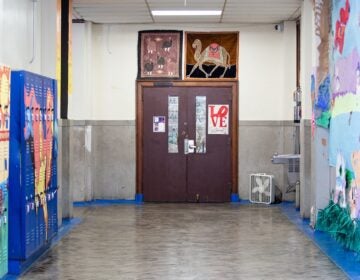
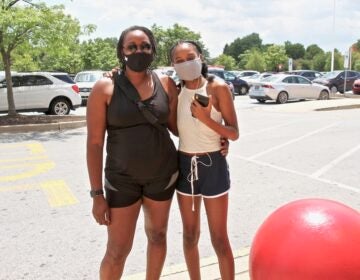
![CoronavirusPandemic_1024x512[1]](https://whyy.org/wp-content/uploads/2020/03/CoronavirusPandemic_1024x5121-300x150.jpg)
